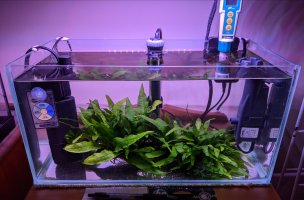Hi Everyone,
Ever since reading Diana Walstad's Ecology of the Planted Aquarium book on the topic of most plants preferring ammonium over nitrate, I have been digging deeper into this. And, I have found some interesting stuff that I'd like to share. In particular, I have been drawn to the use of Urea. My understanding is that aquarium plants absorb Urea and break it down into ammonium and carbon dioxide. I believe plants use an enzyme called urease to do this. So, presumably this ammonium (inside the plant structure) doesn't pose a risk to tank livestock such as fish?
I discovered a fertilizer known as Eudrakon N as follows:
Eudrakon N Nitrogen Fertilizer Solution
However, the blurb for this product does state that "Urea...can be directly absorbed by plants on the one hand or also hydrolyzed by the bacteria in the tank into ammonium and CO₂". This being the case, choosing the optimum dose of Eudrakon N would be important to maintain ammonium at a safe level for fish and inverts. And this would apply to other urea-containing fertilizers.
In a sense, this thread is an extension of the following thread that I unintentionally hijacked:
Olympus is Calling.
Thanks again to @Zeus.
I have more to add but that should hopefully get the ball rolling!
JPC
Ever since reading Diana Walstad's Ecology of the Planted Aquarium book on the topic of most plants preferring ammonium over nitrate, I have been digging deeper into this. And, I have found some interesting stuff that I'd like to share. In particular, I have been drawn to the use of Urea. My understanding is that aquarium plants absorb Urea and break it down into ammonium and carbon dioxide. I believe plants use an enzyme called urease to do this. So, presumably this ammonium (inside the plant structure) doesn't pose a risk to tank livestock such as fish?
I discovered a fertilizer known as Eudrakon N as follows:
Eudrakon N Nitrogen Fertilizer Solution
However, the blurb for this product does state that "Urea...can be directly absorbed by plants on the one hand or also hydrolyzed by the bacteria in the tank into ammonium and CO₂". This being the case, choosing the optimum dose of Eudrakon N would be important to maintain ammonium at a safe level for fish and inverts. And this would apply to other urea-containing fertilizers.
In a sense, this thread is an extension of the following thread that I unintentionally hijacked:
Olympus is Calling.
Thanks again to @Zeus.
I have more to add but that should hopefully get the ball rolling!
JPC
Last edited:





